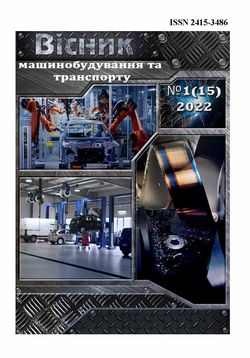Evaluation of the plasticity of the surface layer of metal during rolling of cylindrical parts with a ball
DOI:
https://doi.org/10.31649/2413-4503-2022-15-1-58-66Keywords:
surface plastic deformation, incompressibility condition, strain rate tensor, axisymmetric problem, stress-strain state, damage accumulation, used plastic resourceAbstract
The article deals with the study of the peculiarities of the process of plastic deformation of the surface layer of cylindrical parts during rolling with a ball. The stress-strain state and the regularities of its change, depending on the process parameters in the surface layer of the part, were determined by the slip line method and the finite element method.
The vast majority of parts of mechanisms and machines work in contact with the relevant parts, namely various friction pairs, shafts, rollers, gears or tools, product housings, strikers, and so on. Specific requirements for these parts are due to the peculiarities of the operation of the latter. As a rule, it is impossible to meet all the requirements when making parts from one material. This mainly applies to the requirements of combining the high strength characteristics of the material of the internal volume of the part and the significant hardness of the same material on its surface in contact with the corresponding part. In addition, the surface of the parts under certain conditions must have high wear resistance and low coefficient of friction (antifriction parts) or high coefficient of friction (friction parts), or self-changing surface layer, and sometimes the entire surface must have some porosity and sweat during operation .
The slip line method can be attributed to the traditional methods for solving problems of the theory of plasticity. This method can be used to solve problems in which the equations of equilibrium and plasticity create a closed system of differential equations of hyperbolic type. Therefore, this method can be used for solving plane problems, and only in some cases for solving axisymmetric problems. The solutions that can be obtained if a certain area of slip lines is directly known are called straight lines. When information about the shape of the initial slip lines is insufficient, inverse and semi-inverse methods are used.
A numerical study of the regularities of damage accumulation was carried out, calculations of the accumulated deformation, the stress state index, and the distributions of the used plastic resource over the volume of the plastic zone when rolling with a ball in the environment of a specialized software complex were carried out. The adequacy of the model is checked in comparison with the available experimental data.
On the basis of the research carried out in the article, recommendations can be developed for the choice of processing modes that provide the most rational parameters of the state of the surface layer of parts such as bodies of revolution.
References
О. Л. Гайдамак, В. А. Матвійчук, М. А. Колісник, «Підвищення службових характеристик поверхневого шару деталей шляхом застосування поверхневого пластичного деформування і газодинамічного напилення», Вібрації в техніці та технологіях, № 2 (97), с. 90-100, 2020.
О. Л. Гайдамак, В. А. Матвійчук, «Підвищення довговічності деталей, що працюють при повторно-змінних навантаженнях», Вібрації в техніці та технологіях, № 3 (98), с. 15-24, 2020.
С. В. Ковалевський, С. Ф. Маланчук, «Дослідження поверхневого пластичного деформування гвинтовим накатником», Обработка материалов давлением, № 2 (47), с. 124-127, 2018.
М. М. Косіюк, С. А. Костюк, «Машина для зміцнення зовнішніх поверхонь обертання статико-імпульсною обробкою», Вісник Хмельницького національного університету. Технічні науки, № 6, с. 101-106, 2020.
V. А. Ogorodnikov, I. A. Derevenko, R. I. Sivak, “On the Influence of Curvature of the Trajectories of Deformation of a Volume of the Material by Pressing on Its Plasticity Under the Conditions of Complex Loading”, Materials Science, vol. 54, pp. 326-332, 2018.
В. М. Михалевич, В. А. Матвійчук, І. А. Бубновська, «Оцінка деформовності матеріалу заготовок при вальцюванні», Техніка, енергетика, транспорт АПК, № 2(113), с. 56-64, 2021.
О. В. Грушко, В. А. Огородніков, Ю. О. Слободянюк, «Деформовність маловуглецевого дроту в процесі його багатоступінчастого холодного волочіння», Вісник Вінницького політехнічного інституту, № 3, с. 103-110, 2019.
R. Sivak, “Evaluation of metal plasticity and research of the mechanics of pressure treatment processes under complex loading”, Eastern-European Journal of Enterprise Technologies, № 6/7 (90), pp. 34-41, 2017.
Downloads
-
PDF (Українська)
Downloads: 169



